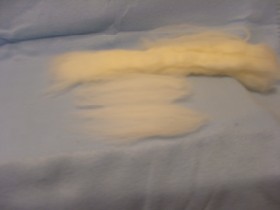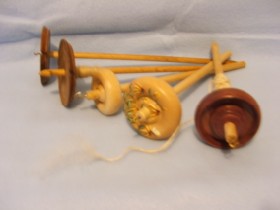|
You have probably found any instructions for the first time spinner very awkward to do. Now is the time to alter your movements
to make things more comfortable for you, so that you can spin as you see others doing - with the spindle hanging down, twirling
away, and the hands doing what is expected of them, without fumbling.
It may be as simple as swapping hands, or changing from a bottom whorl to a top whorl spindle.
But its more likely to be how you hold your hands, without getting cramp!
Both hands have 2 things to do: the fibre hand not only has to hold the fibre, but also draft it and let enough of it
through so it can be spun. Your spindle hand has to keep the spindle twirling, and to control the twist so it doesn't travel
up into your fibre hand and the unspun fibres.
There is an excellent article in Interweave Press's A Hand Spindle Treasury, and its well worth borrowing from your local
library. Just like using a computer, there is an ergonomically correct position for your hand, basically having the top of
your hand parallel with the ground, and your arm level so that you are not trying to lift your arms or hand on top of everything
else you are trying to do. If you can feel a bit of stress on your muscles, you are not doing it right.
What your fingers are doing will depend rather on how you hold your fibre. There is no need to worry about whether you
are doing a long draw or a short draw at this stage!

I like to spin from the fold. The fibres run parallel to each other across the top or batt I am using, and they are folded
in the middle over my fore or middle finger. My palm holds the greater part of them out of the way of the spindle. This is
ideal if you are spinning longer fibres such as Leicester, Romney and even some Corriedale. I have found merino top can be
a bit short for this.
To prepare, take a clump of combed or carded fibres and spread them out. If you are using commercial top, have a look
to see how long the fibres are, and break off a bit about the right length. You will separate the fibres sideways so they
run freely. Fold them in the middle, and there you have it!

|
| fibres predrafted and ready to fold over the finger |
If your fibres are much shorter, you may prefer to split your tops lengthwise until you have a pencil roving. The easiest
way to cope with the length is to wind it very loosely around your wrist out of the way, so you can tug it gently as you need
more. It will probably come off your wrist and under your palm, so its more likely that you are trying to grasp at it with
your finger tips. I've seen it described as rather like trying to catch a butterfly without harming the wings!
Try not to tense up your fingers, thats asking for trouble! Spinning is not a trial of strength, and the more you relax, the
more you will enjoy it!
Your thumb and the tip of your forefinger will control the twist where necessary, and you will find you can draft out any
thicker patches of fibre quite easily, as long as you keep things as relaxed as possible without dropping everything.
You may get cramp in your spindle twisting hand. Many spinners find it naturally quite easy to spin the spindle with a snap
or click of the fingers. Some of us can't, its just how we are made.
This is why I prefer to thigh roll, and for this you need a longer shaft to your spindle.

Not all the spindles I have in my collection are suitable for thigh rolling, the shafts are simply too short.
Priscilla Gibson-roberts has written a splendid book on this technique: Spinning in the Old Way. Its a republication of her
High Whorling book, and well worth getting hold of to read.
The Hand Spindle Treasury also has some excellent articles on thigh rolling, as it covers many different techniques and styles
of spinning from Navaho to Icelandic.
Many different cultures use a thigh-supported method of spinning, using both top and bottom whorl spindles, of different weights.
The spinner remains seated. As long as you are happy with the spindle you have, and the shaft is long enough to do it, you
can use whatever spindle you choose to thigh-roll sitting down. Using this method, the actual weight of the spindle is not
so important as it doesn't have to carry the weight of the yarn and you can spin the finest of lace yarns or sturdy rug yarns.
Some spinners have a cup or bowl to support and steady the tip of the spindle - it also helps the spindle spin longer.
I spin left handed, holding the fibre in my right hand, so my technique is slightly different. I do spin sitting down.
I lay the spindle across my left thigh, whorl pointing up and to my right, the shaft pointing down beside me. I hold the
spindle very loosely about half way down the shaft - it fits in the V between my thumb and my fingers, and I guide it down
my thigh, pushing it slightly with the palm of my hand. If I have drafted the fibres well enough I can spin off the tip of
the spindle, but with raw fleece, my preferred fibre, it can get a bit sticky and need a bit of help. In this case the spindle
shoots off my lap and drops downwards twirling merrily and I continue as if its a standard drop spindle, my spindle hand locking
the twist until I am ready for it. Doing it this way I get far more yarn spun in one twirl than when spinning the standard
drop spindle way, and I don't have to do any stretching exercises either. Its a sort of hybrid method of spinning, but works
for me!
The important thing with thigh rolling is to remember which way the spindle is spinning. If you roll the spindle down your
right thigh, you will be spinning with an S twist. Roll it down your left thigh, you are spinning with a Z twist. While spinners
have traditionally spun using a Z twist, and use an S twist when they ply 2 or more lengths of yarn together, its probably
not too important for you to do this, as long as you consistantly spin your yarn the same way. If you mix directions up by
accident, it will cause your knitting stitches to lean a different way. Its also very obvious in weaving, and can affect crochet
too.
Basically, there is no right or wrong way to spin with a spindle, as long as you are happy with the results. It takes practice
to spin an even yarn, and then how you will long to spin a lumpy bumpy yarn, just like your first efforts, as an accent yarn
for your fibre project, because no matter how much you try, you will never again be able to reproduce your first efforts.
So save your first born yarns, there is plenty you can do with them:
learn how to dye with food dyes
use it to experiment with other fibre crafts
Above all, have fun! This can be a most addictive craft, and you will get to meet some of the most amazing people around the
world. You will also get to go shopping around the world as you discover all the fabulous fibres that you can spin!
And remember:
There is no such thing as too much fibre, just not enough storage space!
Happy spinning!
Lots of spinning How-tos from Rosemary Brock's textile links:
Now you have grasped the basics, why not treat yourself to a hand-crafted spindle? Australians (and everyone else for that
matter!) are lucky to have the talented John Reeves to custom make one out of specially selected Australian timbers, already
tested for their suitability and spin-ability. His web-site will soon be up and running at www.dropspindles.com.au, and he
can be found at Ebay Australia in the Spinning section, as well as Etsy.
John Reeves lovely turned Australian spindles!
And here are two links to spinner's videos to help you perfect your techniques. Remember, there is no right or wrong way to
spin, just the way that works best for you, and there are lots of different techniques out there!
Abby Franquemont's videos on You Tube
Amanda's downloadable videos and tutorials
|
